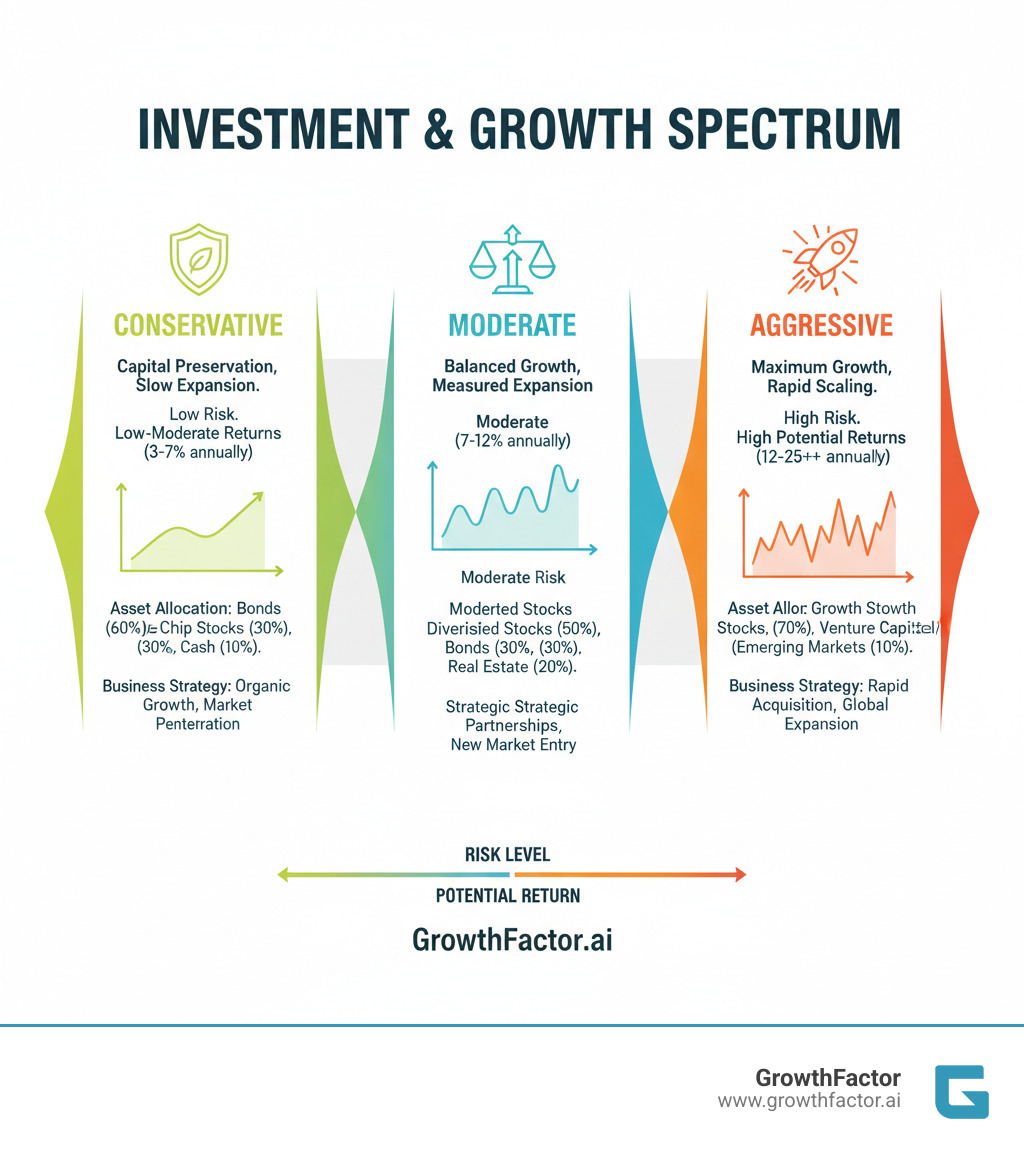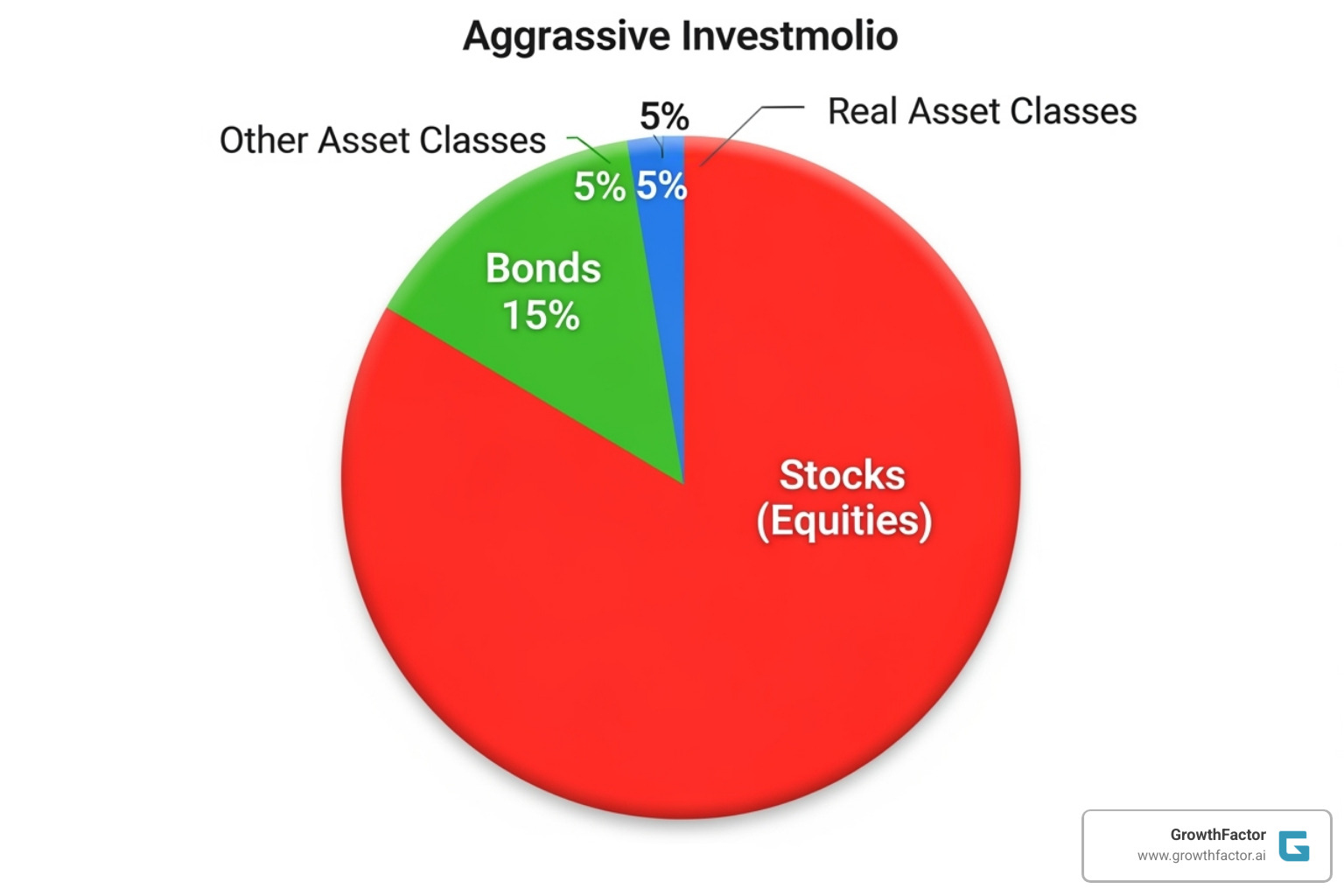Beyond the Basics: Demystifying Aggressive Investment
Why Aggressive Growth Strategy Demands Your Attention

Aggressive growth strategy represents the high-stakes pursuit of maximum capital appreciation, whether you're building an investment portfolio or expanding a business empire. This approach prioritizes explosive growth over safety, accepting significant short-term volatility for the potential of outsized long-term returns.
Key Components of Aggressive Growth Strategy:
- Investment Focus: 80%+ allocation to high-risk, high-reward assets like equities and growth stocks
- Business Focus: Rapid market expansion, heavy reinvestment, and accepting short-term losses for market dominance
- Risk Profile: High volatility with potential for substantial gains or significant losses
- Time Horizon: Requires 10+ years to weather inevitable downturns and capitalize on compounding
- Ideal Candidates: Young investors or fast-growing businesses with high risk tolerance
The numbers tell a compelling story. Research shows that while aggressive strategies can vastly outperform conservative approaches in cumulative returns, they also experience much higher drawdowns - with Sharpe ratios averaging 0.85 compared to 1.25 for conservative strategies. Yet for those who can stomach the volatility, aggressive growth funds might yield a 21% return one year, lose 5% the next, and gain 7% the following year.
The business parallel is striking. Just as aggressive investors concentrate their portfolios in high-growth assets, aggressive business expansion means doubling down on proven markets, rapidly scaling operations, and making bold moves even during uncertain economic times. The same principles that drive portfolio outperformance - courage, long-term thinking, and strategic resource allocation - apply whether you're picking stocks or picking store locations.
I'm Clyde Christian Anderson, founder of GrowthFactor.ai, and I've spent over a decade applying aggressive growth strategy principles in retail expansion, from loading trucks in warehouses to analyzing real estate deals worth millions. My experience spans both the financial markets and brick-and-mortar retail, giving me unique insight into how aggressive growth strategy works across both investment and business contexts.

Aggressive growth strategy terms simplified:
The Anatomy of an Aggressive Growth Portfolio
When you're diving into an aggressive growth strategy, you're essentially building a financial rocket ship designed to blast off toward maximum capital appreciation. This isn't about playing it safe or collecting steady dividends – it's about making your money work overtime to achieve significant wealth multiplication over time.

The backbone of any aggressive portfolio is its heavy tilt toward equities – we're talking 80% or more. A typical allocation might look like 80% stocks and 20% bonds, or even more boldly, 75% equities, 15% fixed income, and 10% alternatives like commodities or real estate. This concentration in riskier assets is exactly what gives the portfolio its explosive potential.
But here's the thing – this strategy isn't for everyone. The ideal investor needs two crucial qualities: a long time horizon (think 10 to 30+ years) and a stomach made of steel. This approach works best for younger investors who have decades before retirement, giving them plenty of runway to weather the inevitable storms and benefit from compounding growth.
The numbers tell the whole story when we compare aggressive strategies to their more conservative cousins:
| Strategy | Typical Asset Mix (Equities/Bonds/Other) | Risk Level | Primary Objective | Potential Return | Sharpe Ratio (Avg.) | Drawdown (Median) |
|---|---|---|---|---|---|---|
| Aggressive | 80%+ Equities, <20% Bonds/Alternatives | Very High | Capital Appreciation | Highest | 0.85 | -10.8% |
| Moderate | 60-70% Equities, 30-40% Bonds/Cash | Medium | Growth & Income | Moderate | N/A | -5.08% |
| Conservative | 40% Equities, 60%+ Bonds/Cash | Low | Capital Preservation | Lowest | 1.25 | -5.08% |
Notice how aggressive strategies deliver the highest potential returns but come with much deeper drawdowns – sometimes double what conservative approaches experience. That time horizon isn't just a nice-to-have; it's absolutely essential to avoid selling during market dips and locking in devastating losses.
Common Investment Vehicles for High Growth
Building an aggressive portfolio means choosing investments that can really move the needle. Small-cap and micro-cap stocks are often the stars of the show – these companies with market values under $1 billion pack serious growth potential. They're typically innovative newcomers or businesses entering hot new markets, though they also carry the risk of complete loss if things go south.
Emerging market funds offer another compelling avenue for growth. These investments tap into developing economies with explosive potential, but they come with their own challenges like currency fluctuations and political instability. The regulatory landscape in these markets can be particularly tricky, sometimes involving regulatory problems that add extra complexity to investing decisions.
For those seeking professional management with an aggressive bent, growth-oriented ETFs and mutual funds concentrate on companies expected to outpace the broader market. These funds often focus on red-hot sectors like technology and biotech. The most aggressive variant – leveraged ETFs – use derivatives to amplify returns, potentially delivering 2x the daily performance of an underlying index. Of course, this amplification works both ways, magnifying losses just as dramatically as gains.
High-yield bonds (the so-called "junk bonds") round out the fixed-income portion of aggressive portfolios. These speculative-grade bonds from lower-rated companies offer higher coupons but require careful research to avoid companies facing serious financial troubles.
For investors with substantial capital, private equity opens doors to direct investment in startups and growing private companies. These investments typically require commitments of $250,000 or more and involve long lock-up periods, but successful ventures can deliver massive returns. Similarly, certain real estate strategies – like speculative development or highly leveraged property investments – can provide substantial capital gains, though they also bring risks like market downturns and vacancy issues.
Resources like Building an Aggressive Growth Portfolio can provide additional guidance for those ready to construct such a portfolio.
How It Differs from Other Strategies
The key difference between an aggressive growth strategy and other approaches boils down to one word: risk tolerance. While conservative strategies focus on capital preservation with 60% or more in bonds and cash, aggressive investors deliberately accept higher volatility in pursuit of superior returns.
Conservative strategies prioritize safety above all else, typically delivering a Sharpe ratio around 1.25 – indicating solid risk-adjusted returns. However, historical data shows that aggressive strategies vastly outperform conservative approaches in cumulative returns over the long haul, despite their lower Sharpe ratio of around 0.85.
Moderate strategies try to split the difference, balancing growth and income with allocations around 60% equities and 40% bonds. They experience median drawdowns of about -5.08% – roughly half the -10.8% that aggressive portfolios typically endure.
The bottom line? Aggressive investors willingly accept significantly more volatility and deeper drawdowns because they're laser-focused on capital appreciation rather than income generation or financial safety nets. This fundamental difference in risk tolerance shapes every aspect of how these portfolios are constructed and managed.
The High-Stakes Game: Rewards vs. Inherent Risks
Choosing an aggressive growth strategy is like stepping into a casino where the stakes are your financial future – except here, time and knowledge stack the odds in your favor. The potential rewards can be absolutely transformative. We're talking about superior cumulative returns that could multiply your wealth several times over the decades.
Picture this: while your conservative-investing friend celebrates a steady 5% annual return, your aggressive portfolio might deliver that eye-popping 21% return in a good year. Over 20 or 30 years, that difference compounds into life-changing wealth. The numbers don't lie – an aggressive strategy has historically vastly outperformed conservative approaches in cumulative returns over the long haul.
But here's where things get interesting (and a bit nerve-wracking). That same aggressive portfolio that gave you 21% one year might lose 5% the next, then bounce back with a 7% gain the following year. This rollercoaster ride is precisely what separates aggressive investors from the rest.
The risks are real and substantial. High volatility becomes your constant companion – your portfolio value will swing dramatically, sometimes losing thousands of dollars in value in a single day. During broad market downturns, growth stocks get hit disproportionately hard because they're often valued on future potential rather than current earnings.
Then there's the sobering reality of significant drawdowns. While moderate strategies might see median drawdowns around -5.08%, aggressive strategies regularly experience drawdowns of -10.8% or higher. In extreme cases, there's even a risk of ruin – the possibility of losing all or most of your invested capital, especially with highly concentrated or leveraged positions.
This is why understanding your risk tolerance isn't just helpful – it's absolutely critical. For deeper insights into managing this balance, A Guide to Aggressive Investment Strategy offers valuable perspectives on navigating these choppy waters.
Understanding the Key Risks of an Aggressive Growth Strategy
Let's get specific about what keeps aggressive investors awake at night (though hopefully not too often). These risks aren't just academic concepts – they're real factors that can significantly impact your financial future.

Market risk is the big kahuna. When the overall market decides to take a nosedive, your growth stocks don't just follow – they often lead the way down. This happens because growth companies are typically valued on their future potential rather than current profits. When investor sentiment sours, these "story stocks" get punished first and hardest.
Liquidity risk can catch you off guard in the worst possible moments. Those exciting small-cap stocks or private equity investments that promise huge returns? They can be incredibly difficult to sell when you need cash. Imagine wanting to exit a position during a market panic, only to find no buyers – or worse, buyers offering pennies on the dollar.
Regulatory and political risks become especially relevant when chasing growth in emerging markets. These regions offer tremendous upside potential, but they also come with unstable institutions and unpredictable governance. A sudden change in government policy, new taxation rules, or currency controls can devastate your investments overnight. The regulatory problems that occasionally surface in these markets serve as stark reminders that not all growth opportunities are created equal.
The key takeaway? These risks aren't meant to scare you away from aggressive growth – they're meant to help you make informed decisions. Understanding what you're signing up for is the first step toward building a strategy that can weather these storms and emerge stronger on the other side.
Applying an Aggressive Growth Strategy to Business Expansion
Let's make the jump from investment portfolios to the real world of business expansion. The beauty of an aggressive growth strategy is that its core principles translate perfectly from the stock market to the retail floor. Instead of chasing maximum capital appreciation through equities, we're pursuing rapid market domination through strategic expansion.
Think about it this way: just as aggressive investors accept short-term volatility for long-term gains, aggressive business expansion means accepting short-term losses for future market leadership. You might saturate a promising market with multiple locations, knowing that some won't turn a profit immediately. The goal isn't quick wins – it's market dominance.
I've seen this play out countless times in retail. A brand identifies an underserved market, then moves fast and decisively. They'll open three stores when their conservative analysis suggests one would be safe. They'll launch in multiple states simultaneously rather than testing one market at a time. It takes guts, but that's exactly what separates aggressive growth from playing it safe.
The parallels between investing and business expansion run deep. Market penetration becomes your equivalent of buying more shares in a winning stock – you double down on what's working by maximizing sales within your existing customer base through aggressive pricing or marketing. Product development mirrors investing in growth stocks – you're betting big on innovation and new offerings that might not pay off immediately but could transform your business.
Then there's market expansion, which is perhaps the most direct parallel. This is where you take your proven concept and replicate it rapidly across new territories. It's risky, capital-intensive, and requires the same long-term thinking that drives aggressive investment strategies. A solid market entry strategy becomes as crucial as a well-researched stock pick.
A Modern Approach to an Aggressive Growth Strategy
Here's where things get exciting. Today's aggressive growth strategy in retail isn't just about opening stores fast – it's about opening the right stores fast. We're living in an era where gut instinct gets turbocharged by artificial intelligence and data analytics.
At GrowthFactor, we've watched this change firsthand. Using AI for data-driven site selection means you can expand aggressively without flying blind. Instead of guessing which corner will work, you're analyzing foot traffic patterns, competitor locations, local spending habits, and demographic trends. It's like having insider information for every potential site.
Think of this as the "mid cap plus" strategy of retail expansion. Just as mid-cap companies often outperform both large and small caps by finding that sweet spot of growth and stability, smart retailers target markets that are ripe for entry but not yet saturated. You want to get there before the mega-chains notice, but after the market has proven itself viable.
Modern aggressive growth weaves together multiple strategies seamlessly. Strategic partnerships open doors to new markets without the full capital investment of going it alone. Digital marketing amplifies your expansion by building brand awareness in new territories before you even open doors. Employee development ensures you have the talent pipeline to staff rapid expansion without compromising quality.
The key differentiator today is continuous innovation – not just in products, but in how you expand. Some retailers are using acquisition strategies to buy their way into new markets quickly. Others are integrating sustainability initiatives that actually accelerate growth by attracting value-conscious consumers.
What ties it all together is AI-powered retail analytics. These tools let you track performance across multiple new locations in real-time, spot problems before they become disasters, and identify which expansion strategies are working best. It's the difference between expanding blindly and expanding intelligently.
The bottom line? An aggressive growth strategy in business requires the same courage as aggressive investing, but with better tools than ever before to stack the odds in your favor.
Frequently Asked Questions about Aggressive Growth
We often get asked about the practicalities and nuances of an aggressive growth strategy. Let's tackle some of the most common questions head-on.
What is the most aggressive way to invest?
The most aggressive methods typically involve a high concentration in volatile assets, aiming for maximum capital appreciation with little regard for capital preservation or income generation. Think of it as putting all your eggs in the highest-risk baskets.
Small-cap and micro-cap stocks represent one of the most aggressive approaches, where you're investing heavily in smaller, less-established companies. These offer significant upside potential but also carry a higher risk of business failure. Leveraged ETFs take things even further by using financial derivatives to amplify the daily returns (or losses) of an underlying index, making them extremely volatile and suitable only for very short-term, highly speculative plays.
For those comfortable with complexity, options and futures trading can offer massive payoffs from relatively small capital outlays. However, they also come with the potential for massive, rapid losses that often exceed the initial investment. Private equity in startups through angel investing or venture capital carries a high risk of total loss but also the potential for exponential returns if a startup succeeds.
Perhaps the most aggressive approach involves concentrated sector bets - placing a large portion of your portfolio into a single, high-growth sector like emerging technology or biotechnology. This maximizes exposure to volatility due to the inherent speculative nature of such industries.
Essentially, the most aggressive way to invest involves minimizing diversification, maximizing exposure to highly volatile or illiquid assets, and often utilizing leverage to amplify both potential gains and losses.
How does an investor's time horizon influence this strategy?
An investor's time horizon is absolutely crucial - perhaps the single most important factor when considering an aggressive growth strategy. A long time horizon, typically 10+ years, isn't just beneficial; it's essential for success.
Here's why time matters so much: weathering volatility becomes possible when you have years ahead of you. Aggressive portfolios will experience significant drawdowns and periods of underperformance. Without adequate time, you might be forced to sell during a market dip due to immediate capital needs, locking in losses and negating the entire purpose of an aggressive strategy.
The power of compounding truly shines over extended periods. Early high returns, even if bumpy, have more time to snowball into substantial wealth. Think of it like planting a tree - the aggressive strategy is choosing a fast-growing species that might struggle in harsh weather, but given enough time, it can tower over the safer, slower-growing alternatives.
For young investors with decades until retirement, a long time horizon acts as a protective buffer, allowing them to ride out the market's inevitable ups and downs while benefiting from the aggressive approach's potential for superior long-term returns.
What role does risk tolerance play in choosing this approach?
Risk tolerance is the single most important factor in choosing an aggressive growth strategy. It's your psychological capacity to endure significant ups and downs - specifically the potential for substantial paper losses - without panicking and making irrational decisions.
Emotional preparedness is everything in this game. An aggressive strategy will test your nerves regularly. Seeing your portfolio drop by 10%, 20%, or even 30% or more can be incredibly stressful. Aggressive strategies can have median drawdowns of -10.8% or higher. If you're not emotionally prepared to withstand these fluctuations, you might sell at the worst possible time, turning temporary paper losses into permanent real losses.
You must deeply understand the fundamental trade-off: higher potential returns come with higher risk. There's no getting around this relationship. If the thought of losing a significant portion of your capital keeps you awake at night, this strategy simply isn't for you.
This approach is unsuitable for risk-averse individuals who prioritize capital preservation or sleeping soundly over maximizing returns. For these investors, an aggressive strategy will likely lead to anxiety and poor decision-making, ultimately defeating its purpose.
The bottom line? While the potential rewards are enticing, you must be brutally honest with yourself about your ability to stomach the ride. An aggressive growth strategy requires a strong stomach, unwavering conviction in your long-term goals, and the discipline to stay the course when markets get turbulent.
Conclusion: Balancing Ambition with Intelligence

Throughout our journey exploring aggressive growth strategy, we've uncovered a fundamental truth: this approach represents one of the most powerful tools available, whether you're crafting an investment portfolio or building a business empire from the ground up. The beauty lies in its core philosophy - embracing calculated risks to open up extraordinary rewards.
For investors, we've seen how an aggressive strategy means putting capital appreciation front and center. Yes, you'll face those stomach-churning moments when your portfolio swings wildly, but history shows us that aggressive strategies vastly outperform conservative approaches in cumulative returns over time. The trade-off is real - higher drawdowns and more sleepless nights - but for those with the right temperament and time horizon, the payoff can be life-changing.
In the business world, particularly in retail expansion, the parallels are striking. Aggressive growth strategy translates into bold moves: rapid market penetration, strategic location selection, and the courage to invest heavily even when short-term profits take a backseat to long-term market dominance.
But here's what separates successful aggressive growth from reckless gambling: intelligence. The most successful investors don't just throw money at high-risk assets; they research, analyze, and make informed decisions. Similarly, the most successful retail expansions aren't based on gut feelings or wishful thinking.
This is where robust data and sophisticated analysis become absolutely critical. In today's competitive retail landscape, executing an aggressive expansion strategy without proper intelligence is like driving blindfolded on a mountain road. You might get lucky, but the odds aren't in your favor.
At GrowthFactor, we've built our entire mission around this principle. We help emerging multi-unit retailers apply aggressive growth principles to their physical footprint with the confidence that comes from data-driven decision making. Our AI-improved platform doesn't just crunch numbers; it reveals those hidden opportunities - the retail equivalent of finding undervalued growth stocks before the market catches on.
Think of it this way: while others are still using outdated demographic reports and driving around neighborhoods with clipboards, you're leveraging cutting-edge technology to identify the perfect storm of foot traffic, consumer behavior, and market gaps. That's not just aggressive growth; that's intelligent aggressive growth.
The key takeaway? Whether you're building wealth through investments or expanding your retail empire, success demands three non-negotiables: a crystal-clear plan, unwavering long-term perspective, and deep understanding of the risks involved. Add intelligent data analysis to that mix, and you've got a recipe for sustainable, explosive growth.
Ready to turn your expansion dreams into data-driven reality? Learn how GrowthFactor supports emerging multi-unit retailers and find how our solutions can transform your aggressive growth objectives from ambitious hopes into achievable milestones.
Citations
The human algorithm
Request Your demo
Schedule meeting
Or submit your information below and we'll be in touch to schedule.



